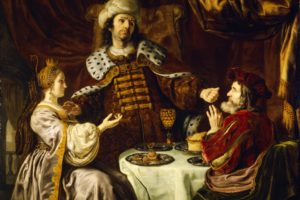Object of the Month: March 2022
Esther Accusing Haman
Oil on canvas, signed and dated on lower left: J. Victoors, fc, 1651
Jan Victors
Dutch, 1619–after 1676
Click on the links throughout the article to further your learning.
One of life’s more pleasurable experiences is eating a good meal. Although, food shared with a friend or a group has the additional benefit of fellowship besides nourishment. There are a few food-related paintings in the M&G collection; however, this Dutch work includes a meal, and it is considered a favorite of many patrons. Added to the collection in 1968, it arrived from Europe unframed and in a shared crate with M&G’s Adoration of the Magi by Jan Boeckhorst.
Jan Victors was born in Amsterdam. His birthdate was deduced from a marriage license in 1642, which he signed at 22 years old. He was predeceased by his wife in 1661 with whom he fathered seven children. In his family there are two other painters, a brother and a son. He was raised in a strict Calvinist environment and painted only biblical scenes that did not include representations of God or Christ—most often themes from the Old Testament. In 1673, he left painting and a comfortable life in Amsterdam to minister to sailors of the East India company. He continued in this missionary endeavor until 1676 when he apparently succumbed to a fever while in the Dutch East Indies, now Indonesia.
Victors studied under Rembrandt and was part of his studio from 1632 to 1635. M&G’s work represents the pinnacle of his artistic skill. The precision and opulence of the table settings and garments reflect the wealth of the upper classes or royalty. Note the variety in the scene’s rich textiles: the heavy and lush curtains, the ermine-trimmed robe and brocade garment on King Ahasuerus, Queen Esther’s pearls and jewels as well as her silk dress embroidered with gold, and Haman’s silk-lined velvet garb featuring the 17th-century’s highly fashionable paned sleeves. The silver tableware is linked to well-known silversmiths of the day, the Van Vianens. The pineapple-shaped goblet resembles a design that was created by none other than Albrecht Durer.
Victors painted this same subject at least two other times prior to M&G’s work. Both are in Germany, one in Wallraf-Richartz Museum in Cologne (1645-1639) and the other in the Gemäldegalerie Alte Meister in Kassel (c.1640).
Like many of his Dutch contemporaries, he painted biblical subjects representing Israel’s history. The Dutch identified with the captivity and persecution of the Jewish people having fought for their own independence from Roman Catholic Spain in the Eighty Years’ War.
Esther is a wonderful example of the providence of God, revealing His care for His chosen people—a quality of God’s character that believers can still trust today. The story for this painting is found in chapter 7 of the book of Esther, and the Jews’ victory over the evil Haman is still observed annually in March as the Feast of Purim.
John Good, Security Manager
Published 2022
